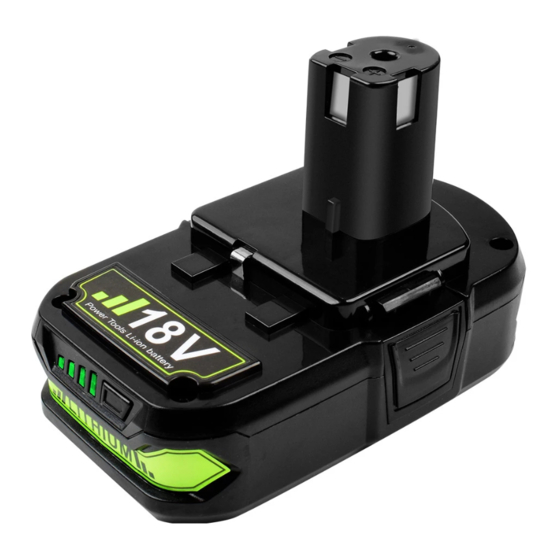
Publicidad
Idiomas disponibles
Idiomas disponibles
18 VOLT LITHIUM-ION
BATTERY PACKS
P103, P104
Always mention the above model
numbers when communicating with
us regarding battery pack.
Use battery pack for Ryobi cordless products only. Refer to
the Operator's Manual provided with product.
SAFETY RULES
WARNING!
READ AND UNDERSTAND ALL INSTRUCTIONS. Failure
to follow all instructions listed below, may result in electric
shock, fire and/or serious personal injury.
Battery tools do not have to be plugged into an elec-
trical outlet; therefore, they are always in operating
condition. Be aware of possible hazards when not us-
ing your battery tool or when changing accessories.
Following this rule will reduce the risk of electric shock,
fire, or serious personal injury.
Do not place battery tools or their batteries near fire
or heat. This will reduce the risk of explosion and possibly
injury.
Do not crush, drop or damage battery pack. Do not
use a battery pack or charger that has been dropped
or received a sharp blow. A damaged battery is subject
to explosion. Properly dispose of a dropped or damaged
battery immediately.
Batteries can explode in the presence of a source of
ignition, such as a pilot light. To reduce the risk of seri-
ous personal injury, never use any cordless product in the
presence of open flame. An exploded battery can propel
debris and chemicals. If exposed, flush with water imme-
diately.
Do not charge battery tool in a damp or wet location.
Following this rule will reduce the risk of electric shock.
Use battery only with charger listed. For use with
18V nickel-cadmium and 18V lithium-ion battery packs,
see tool/appliance/battery pack/charger correlation
supplement 987000-432.
For best results, your battery tool should be charged
in a location where the temperature is more than 50°F
but less than 100°F. To reduce the risk of serious personal
injury, do not store outside or in vehicles.
Under extreme usage or temperature conditions, bat-
tery leakage may occur. If liquid comes in contact with
your skin, wash immediately with soap and water. If
liquid gets into your eyes, flush them with clean water
for at least 10 minutes, then seek immediate medical
attention. Following this rule will reduce the risk of serious
P103
personal injury.
When battery pack is not in use, keep it away from
other metal objects like: paper clips, coins, keys, nails,
screws, or other small metal objects that can make a
connection from one terminal to another. Shorting the
battery terminals together may cause sparks, burns, or a
fire.
Always remove battery pack from your tool when you
are assembling parts, making adjustments, cleaning,
or when not in use. Removing battery pack will prevent
accidental starting that could cause serious personal injury.
Always remove battery pack before storing the device.
P104
When battery becomes fully charged, unplug the
charger from the power supply and remove the battery
pack from the charger.
Always wear eye protection with side shields marked
to comply with ANSI Z87.1, along with hearing protec-
tion. Failure to do so could result in objects being thrown
into your eyes and other possible serious injuries.
Save these instructions. Refer to them frequently and use
them to instruct others who may use this tool. If you loan
someone this tool, loan them these instructions also.
FUEL GAUGE (P104 ONLY)
See Figure 1.
To display the amount of charge left in the battery, press and
hold the fuel gauge button.
If the charge indicator light glows green, the battery pack
is fully charged.
If it glows yellow, it has a usable charge remaining but will
soon require recharging.
If it glows red, the battery requires recharging as indicated
by the fuel gauge symbols on top of the battery.
CHARGE
INDICATOR
LIGHT
FUEL
GAUGE
BUTTON
GREEN =
FULL CHARGE
OPERATION
YELLOW =
USABLE CHARGE
REMAINS BUT WILL
SOON REQUIRE
RECHARGING
P104
RED =
REQUIRES
RECHARGING
Fig. 1
Publicidad
Tabla de contenido

Resumen de contenidos para Ryobi P103
- Página 1 When battery becomes fully charged, unplug the us regarding battery pack. charger from the power supply and remove the battery Use battery pack for Ryobi cordless products only. Refer to pack from the charger. the Operator’s Manual provided with product.
- Página 2 To remove the battery pack from the charger, depress the Ryobi is a registered trademark of Ryobi Limited used under license. ® latches on each side of the battery pack.
-
Página 3: Blocs-Piles De Lithium-Ion
Le fait de retirer le bloc-piles permet d’empêcher un démarrage P104 N’utiliser le bloc-piles que pour les produits Ryobi accidentel pouvant entraîner des blessures graves. sans fil. Consulter le manuel d’utilisation fourni Toujours retirer le bloc-piles avant d’entreposer le dispositif. - Página 4 CARACTÉRISTIQUES RELATIVES À LA vérification électrique. PROTECTION DES BLOC-PILES BLOC-PILES Les bloc-piles au lithium ion One+ de Ryobi sont conçues de manière à protéger les piles au lithium ion et à maximiser Les bloc-piles utilisées dans le bloc d’alimentation sont l’autonomie des bloc-piles.
-
Página 5: Reglas De Seguridad
Use el paquete de baterías solamente con productos inalámbricos de baterías del cargador. Ryobi. Consulte el manual del operador suministrado con el Siempre póngase protección ocular con protección lateral producto. - Página 6 BATERÍAS circunstancias normales. Para cargar normalmente las baterías Las baterías de iones de litio Ryobi One+ de 18 V están diseñadas consulte la sección “CÓMO CARGAR EL PAQUETE DE con características que protegen las celdas de iones de litio y BATERÍAS”.



